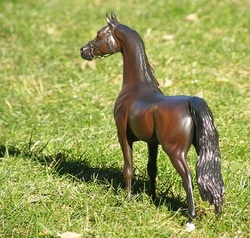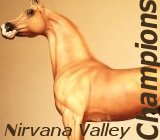The AuSable Collection
Arabian Horse Chacateristics . . .

Arabian horses have refined, wedge-shaped heads, a broad forehead, large eyes, large nostrils, and small muzzles. Most display a distinctive concave or "dished" profile. Many Arabians also have a slight forehead bulge between their eyes, called the "jibbah" by the Bedouin, that adds additional sinus capacity, believed to have helped the Arabian horse in its native dry desert climate. Another breed characteristic is an arched neck with a large, well-set windpipe set on a refined, clean throatlatch. This structure of the poll and throatlatch was called the mitbah or mitbeh by the Bedouin, and in the best Arabians is long, allowing flexibility in the bridle and room for the windpipe.
Other distinctive features are a relatively long, level croup and naturally high tail carriage. Well-bred Arabians have a deep, well-angled hip and well laid-back shoulder. Most have a compact body with a short back. Some, though not all, have 5 lumbar vertebrae instead of the usual 6, and 17 rather than 18 pairs of ribs. Thus, even a small Arabian can carry a heavy rider with ease. Arabians usually possess dense, strong bone, sound feet, and good hoof walls. They are especially noted for endurance.
* Photo above is of SMS Soliantu, owned by Silver Moon Studfarm
Other distinctive features are a relatively long, level croup and naturally high tail carriage. Well-bred Arabians have a deep, well-angled hip and well laid-back shoulder. Most have a compact body with a short back. Some, though not all, have 5 lumbar vertebrae instead of the usual 6, and 17 rather than 18 pairs of ribs. Thus, even a small Arabian can carry a heavy rider with ease. Arabians usually possess dense, strong bone, sound feet, and good hoof walls. They are especially noted for endurance.
* Photo above is of SMS Soliantu, owned by Silver Moon Studfarm
Size
The breed standard for Arabian horses, as stated by the United States Equestrian Federation, describes the Arabians as standing between 14.1 and 15.1 hands(140-155 cm) tall, "with the occasional individual over or under." Thus, all Arabians, regardless of height, are classified as "horses," even though 14.2 hands is the traditional cutoff height between a horse and a pony. Because many horse owners in Europe and the Americas prefer taller animals, the Arabian has been bred for increased height, and many Arabians today are between 15 and 16 hands (60-64 inches at the withers).
Temperament
For centuries, Arabian horses lived in the desert in close association with humans.For shelter and protection from theft, prized war mares were sometimes kept in their owner's tent, close to children and everyday family life. Only horses with a naturally good disposition were allowed to reproduce. The result is that Arabians today are one of the few breeds which the United States Equestrian Federation allows children to exhibit stallions in show ring classes limited to riders under 18.
On the other hand, the Arabian is also classified as a "hot-blooded" breed, a category that includes other refined, spirited horses bred for speed, such as the Thoroughbred and the Barb. Like other hot-bloods, Arabians' sensitivity and intelligence enable quick learning and greater communication with their riders. However, their intelligence also allows them to learn bad habits as quickly as good ones. Combined with their pride, they can quickly lose trust in a poor rider and do not tolerate inept or abusive training practices.
Colors
The Arabian Horse Association recognizes purebred horses with the coat colors bay, gray, chestnut, black, and roan. Bay is the most common color, followed by gray, and then chestnut. Black is somewhat rare. As noted below, true roan may not actually exist in Arabians; rather, roaning in the Arab could simply be a manifestation of the sabino or rabicano genes.
All Arabians, no matter the coat color, have black skin, except under white markings. Black skin provided protection from the hot desert sun.
Although many Arabians appear "white," this is the natural action of the gray gene. Gray horses are born bay, black or chestnut, then get progressively lighter as they age, until their hair coat eventually turns pure white or becomes "flea-bitten" gray. Their skin is black and remains so throughout their life. Therefore, all "white" Arabians are actually grays. There is no such thing as a genetically "white" Arabian, although there have been an extremely small number of Arabians registered as "white" for other reasons.
Black Arabians are not common. There are assorted and contradictory myths about black horses alleged to come from the Bedouin. Some areas considered black Arabians to be a bad omen, in other areas they were a valued treasure. One scientific reason that black is not common is that the black gene is genetically suppressed by the more dominant Agouti gene that creates the black points of a bay horse. Some breeding farms now use DNA testing to increase the probability of producing black Arabians.
The Bedouin had other assorted beliefs about color. It is also said that a particular type of "flea-bitten" gray with localized aggregations of pigment, known as a "bloody-shouldered" horse, was prized as a superior animal, particularly if a mare. Yet another myth is that the first "bloody shouldered" horse was a mare who mourned her rider, killed in war, and forever kept the stains left from the blood of her long-lost companion.
Colors that do not exist in purebreds
Arabians are crossed with other breeds to produce half-Arabians with additional colors. Purebred Arabians never carry dilution genes such as the dun gene, nor the cream gene. Because they do not carry any dilution genes, purebred Arabians cannot be cremello, perlino, palomino or buckskin. Arabians also never carry the proposed "dominant white" (W) gene that produces a true white horse (with pink skin and blue or light-colored eyes).
Purebred Arabians today do not possess genes for most spotting patterns, such as pinto or Appaloosa, except for sabino, discussed here. Spotting or excess white was once thought by some to be a sign of "impure" blood, was disfavored by Arabian breeders, and believed by some to be a mark of impurity until DNA testing for verification of parentage became standard. For a time, horses with belly spots and other white markings deemed excessive could not even be registered, and even after the rule was softened, excess white was sometimes penalized in the show ring. Nonetheless, there is pictorial evidence from depictions of chariot horses in Ancient Egypt and some later artwork that suggests that some of these patterns may have existed in antiquity.
Thus, though the purebred Arabian produces a limited range of potential colors, there is also a positive result: because they never carry the white gene ("W") or the frame overo gene ("O"), they can never produce foals with lethal dominant white ("WW") or lethal white syndrome. (Though a partbred could carry these genes if the non-Arabian parent was a carrier).
The breed standard for Arabian horses, as stated by the United States Equestrian Federation, describes the Arabians as standing between 14.1 and 15.1 hands(140-155 cm) tall, "with the occasional individual over or under." Thus, all Arabians, regardless of height, are classified as "horses," even though 14.2 hands is the traditional cutoff height between a horse and a pony. Because many horse owners in Europe and the Americas prefer taller animals, the Arabian has been bred for increased height, and many Arabians today are between 15 and 16 hands (60-64 inches at the withers).
Temperament
For centuries, Arabian horses lived in the desert in close association with humans.For shelter and protection from theft, prized war mares were sometimes kept in their owner's tent, close to children and everyday family life. Only horses with a naturally good disposition were allowed to reproduce. The result is that Arabians today are one of the few breeds which the United States Equestrian Federation allows children to exhibit stallions in show ring classes limited to riders under 18.
On the other hand, the Arabian is also classified as a "hot-blooded" breed, a category that includes other refined, spirited horses bred for speed, such as the Thoroughbred and the Barb. Like other hot-bloods, Arabians' sensitivity and intelligence enable quick learning and greater communication with their riders. However, their intelligence also allows them to learn bad habits as quickly as good ones. Combined with their pride, they can quickly lose trust in a poor rider and do not tolerate inept or abusive training practices.
Colors
The Arabian Horse Association recognizes purebred horses with the coat colors bay, gray, chestnut, black, and roan. Bay is the most common color, followed by gray, and then chestnut. Black is somewhat rare. As noted below, true roan may not actually exist in Arabians; rather, roaning in the Arab could simply be a manifestation of the sabino or rabicano genes.
All Arabians, no matter the coat color, have black skin, except under white markings. Black skin provided protection from the hot desert sun.
Although many Arabians appear "white," this is the natural action of the gray gene. Gray horses are born bay, black or chestnut, then get progressively lighter as they age, until their hair coat eventually turns pure white or becomes "flea-bitten" gray. Their skin is black and remains so throughout their life. Therefore, all "white" Arabians are actually grays. There is no such thing as a genetically "white" Arabian, although there have been an extremely small number of Arabians registered as "white" for other reasons.
Black Arabians are not common. There are assorted and contradictory myths about black horses alleged to come from the Bedouin. Some areas considered black Arabians to be a bad omen, in other areas they were a valued treasure. One scientific reason that black is not common is that the black gene is genetically suppressed by the more dominant Agouti gene that creates the black points of a bay horse. Some breeding farms now use DNA testing to increase the probability of producing black Arabians.
The Bedouin had other assorted beliefs about color. It is also said that a particular type of "flea-bitten" gray with localized aggregations of pigment, known as a "bloody-shouldered" horse, was prized as a superior animal, particularly if a mare. Yet another myth is that the first "bloody shouldered" horse was a mare who mourned her rider, killed in war, and forever kept the stains left from the blood of her long-lost companion.
Colors that do not exist in purebreds
Arabians are crossed with other breeds to produce half-Arabians with additional colors. Purebred Arabians never carry dilution genes such as the dun gene, nor the cream gene. Because they do not carry any dilution genes, purebred Arabians cannot be cremello, perlino, palomino or buckskin. Arabians also never carry the proposed "dominant white" (W) gene that produces a true white horse (with pink skin and blue or light-colored eyes).
Purebred Arabians today do not possess genes for most spotting patterns, such as pinto or Appaloosa, except for sabino, discussed here. Spotting or excess white was once thought by some to be a sign of "impure" blood, was disfavored by Arabian breeders, and believed by some to be a mark of impurity until DNA testing for verification of parentage became standard. For a time, horses with belly spots and other white markings deemed excessive could not even be registered, and even after the rule was softened, excess white was sometimes penalized in the show ring. Nonetheless, there is pictorial evidence from depictions of chariot horses in Ancient Egypt and some later artwork that suggests that some of these patterns may have existed in antiquity.
Thus, though the purebred Arabian produces a limited range of potential colors, there is also a positive result: because they never carry the white gene ("W") or the frame overo gene ("O"), they can never produce foals with lethal dominant white ("WW") or lethal white syndrome. (Though a partbred could carry these genes if the non-Arabian parent was a carrier).
.: Patron Supporters :.

Click to join TheAuSableCollection
New horses, tack makers, customizers, Breeders and Show dates/results will be announced directly to members of this group. Our online show series will also be held here."The Horse: Friendship without envy, Beauty without vanity, Nobility without conceit, A willing partner, yet no slave."
~ Author Unknown
~ Author Unknown
Legal Information
This is a MODEL HORSE site. Any real horses mentioned on this website are used for entertainment and educational purposes only & are indicated with a -r after their name.
This is a MODEL HORSE site. Any real horses mentioned on this website are used for entertainment and educational purposes only & are indicated with a -r after their name.
© 2007 - present The AuSable Collection







